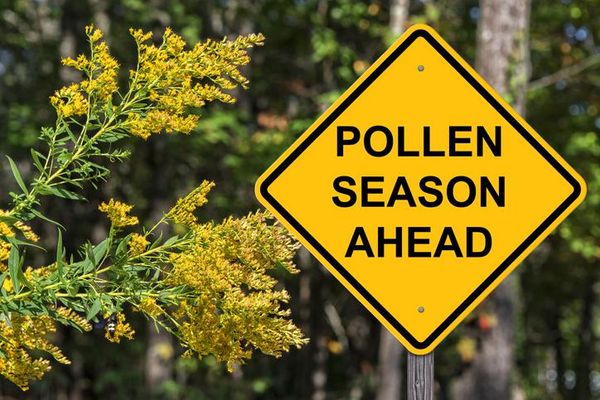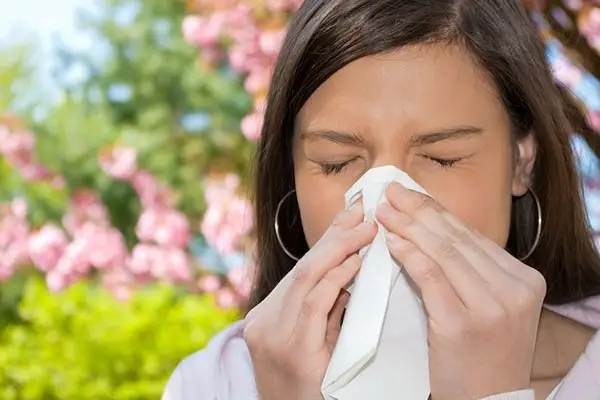An estimated 50 million people in the United States experience some type of allergy, most of which rear their ugly heads during early childhood, according to the American College of Allergy, Asthma & Immunology (ACAAI). In fact, your child is more likely to experience an allergy than any other chronic illness.
Types of allergies and their symptoms
Dust and pollen allergies are both common and may result in a runny or itchy nose, sneezing, stuffiness and watery eyes. You may suspect that your child has a dust allergy is if he or she experiences these symptoms when you dust, sweep or vacuum. Interestingly, it may not be the dust that causes the reaction, but tiny, eight-legged dust mites, which have certain proteins in their bodies and feces to which humans are sensitive.
Hay fever, also known as allergic rhinitis, is a reaction to mold spores and pollen from ragweed, grasses and trees. About 40 million Americans experience this allergy.
Pet allergies occur in about 10 percent of the population, according to the ACAAI. As Fido or Fluffy sheds its fur, your child may experience watery eyes, sneezing or swelling where they came into contact with the animal. Pet dander, skin flakes, saliva and urine can cause allergic reactions in people sensitive to these allergens. Your child's allergies may also flare in response to the pollen, mold spores and other outdoor allergens brought inside on your animal's fur.
Insect sting allergies can make an unwanted encounter with a bee very dangerous. If your child is stung and develops hives, itchiness, difficulty breathing, low blood pressure, dizziness, unconsciousness or swelling of the tongue or any other area other than the sting site, you should seek immediate medical attention.
Food allergies are relatively rare—the ACAAI estimates the prevalence to be around 4 percent—but can cause serious, life-threatening reactions. Sensitivity or intolerance to peanuts, tree nuts, shellfish or other foods may result in severe swelling of the throat, which requires immediate medical attention.
Some children also experience delayed contact allergies caused by touching a substance such as nickel, polishes, rugs, fabric softeners, deodorants, cosmetics, perfumes, preservatives and dyes. And don't forget plants like poison ivy, poison oak and sumac. These plants contain a compound that can cause severe skin reactions in people who are allergic—up to 85 percent of Americans. Such reactions occur two days after exposure and can persist for weeks without treatment.
What to do if an allergy is suspected
To reduce the chances of a serious reaction, it's important to receive prompt diagnosis of an allergy if one is suspected. An allergist is the best person for this job, and you can find a certified physician on the ACAAI website (www.acaai.org) or through the American Academy of Allergy, Asthma & Immunology (www.aaaai.org).
According to the Nemours Foundation, there are skin tests for allergies that tend to be pretty reliable in kids older than 2.
In one method, a physician drops a bit of the suspected allergen on your child's skin, and then gently pricks the area to see what reaction occurs. An allergist may also inject a small amount of the allergen under the skin— don't worry, it's not as painful as it sounds—and wait 15 minutes to see whether a bump appears. If a skin test doesn't yield results or if your child's reactions are especially severe, a blood test may be required.
If your child is diagnosed with an allergy
Your health care professional should give you instructions on helping your child avoid triggers, as well as how to treat reactions. If your child suffers any severe allergic reaction—such as anaphylactic shock or asthma that causes shortness of breath or difficulty breathing, or any other extreme discomfort—you should seek medical attention immediately.
Your health care professional may also prescribe medications, recommend over-the-counter remedies or suggest allergy shots or injections. Although there is no cure for allergies, treatments can provide varying degrees of relief from allergy symptoms.
Depending on your child's allergies, you can help him or her avoid the allergens that trigger symptoms. In cases of airborne allergens, such as dust and pollen, it helps to use an air conditioner inside your home and car. Special air-filtering devices can be added to your home's heating and cooling systems. In addition, portable air cleaning devices used in individual rooms can be helpful. Ask your health care professional which type would be best. Following are some helpful tips for avoiding exposure to various allergens.
Pollens
Unfortunately, short of staying indoors when pollen counts are high—and even that may not help—there's no easy way to evade all wind-borne pollen. Here are some things you can do:
- Help your child avoid outdoor areas that have just been mowed or contain a lot of plant life.
- Limit your child's outdoor play during allergy season, which can vary depending on what pollens trigger the allergic reactions.
- Plan your vacation at the height of the expected pollinating period, and choose a location where such exposure would be minimal, such as the seashore.
- Keep your child indoors during times of highest pollen counts, usually early in the morning on warm, dry, breezy days.
- If your child must be out when pollen levels are high, consider using a face mask designed to keep pollen from reaching nasal passages.
Molds
Mold allergens, too, can be difficult to avoid. Here are some tips to reduce exposure:
- Teach your child to avoid places where molds grow. Outdoors this includes damp shady areas and garden compost piles. Indoor hot spots include damp basements and closets, bathrooms, air conditioners, humidifiers, garbage pails, upholstered furniture and old foam rubber pillows.
- Keep the lawn mowed and leaves raked, and don't ask your child with allergies to do these chores.
- Avoid walks through tall vegetation, and avoid travel in the country while crops are being harvested.
- Ensure moldy indoor places, such as summer cabins, are aired out and cleaned before your child spends time there.
- Use a dehumidifier to dry the basement, and be sure to frequently remove the water collected in the machine to prevent mold growth.
- Open a window or use a fan after a warm or steamy shower to allow the humidity to escape.
Dust mites
Dust mites are most effectively reduced by decreasing the amount of dust in your home. You can:
- Dust-proof your child's bedroom and other rooms where the child spends time by removing wall-to-wall carpet and blinds. Instead, use window shades or curtains that can be washed periodically in hot water. Hardwood floors with washable throw rugs are easier to remove dust from than carpets. Use vinyl- or leather-covered furniture or washable slipcovers.
- Avoid down-filled blankets and feather pillows.
- Encase bedding in commercially available allergy-proof covers. Woven microfiber materials are more comfortable.
- Wash linens using water hotter than 130 degrees Fahrenheit, which kills dust mite eggs. If you do not want to set your water heater that high, dry your linens at the hottest dryer setting.
- Frequently dust with a damp cloth.
Animals
If you simply can't bear to find another home for your pet, try these suggestions:
- Bathe your pet weekly and brush it outdoors even more frequently (again, don't ask the allergic child to do this task).
- Remove carpets and soft furnishings that trap animal dander and dried proteins in dust.
- Use a vacuum with a HEPA filter.
- Use a room air cleaner with a HEPA filter.
- Keep the pets out of your child's bedroom.
Foods and other ingested substances
- Ask your child's health care professional for the names of different forms of the food that your child should avoid.
- Read food ingredient labels closely to check for the presence of your child's trigger food substances. They are often found in places you wouldn't suspect.
- At a restaurant, don't hesitate to ask about ingredients of various dishes and how they are prepared.
- If your child is allergic to a common medication such as penicillin or has anaphylactic reactions, have him or her wear a medical alert bracelet.
- If your child has severe allergies (such as anaphylaxis), be prepared to treat an exposure at the first sign of a reaction with a syringe of epinephrine, obtained by prescription from your child's health care professional. The shelf life for epinephrine is about 18 months, and then it must be replaced. Be sure you and your child (if old enough) know how to give injections properly. If your child requires an injection, call 911 and get medical help immediately. Until help arrives, have your child lie down and raise his or her legs above chest level to increase blood flow to the heart and brain.







